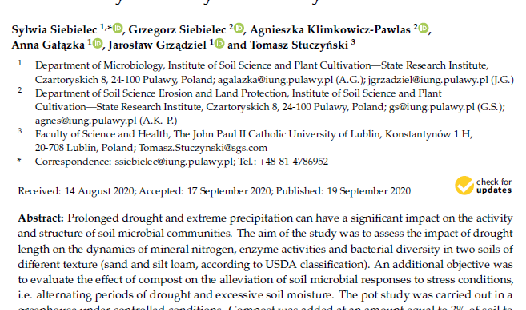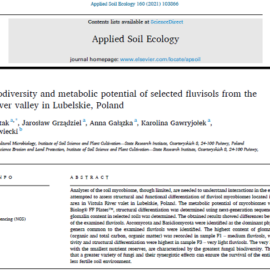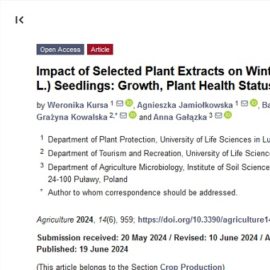Siebielec S., Siebielec G., Klimkowicz-Pawlas A., Gałązka A., Grządziel J., Stuczyński T. (2020): Impact of Water Stress on Microbial Community and Activity in Sandy and Loamy Soils. Agronomy, 10, 1429 (100 pkt. MNiSW, IF = 2.603)
DOI: https://www.mdpi.com/2073-4395/10/9/1429
Abstract
Prolonged drought and extreme precipitation can have a significant impact on the activity and structure of soil microbial communities. The aim of the study was to assess the impact of drought length on the dynamics of mineral nitrogen, enzyme activities and bacterial diversity in two soils of different texture (sand and silt loam, according to USDA classification). An additional objective was to evaluate the effect of compost on the alleviation of soil microbial responses to stress conditions, i.e. alternating periods of drought and excessive soil moisture. The pot study was carried out in a greenhouse under controlled conditions. Compost was added at an amount equal to 3% of soil to the sandy soil, which was characterised by a significantly lower water retention capacity. Specific levels of water stress conditions were created through application of drought and soil watering periods. For each soil, four levels of moisture regimes were set-up, including optimal conditions kept at 60% of field water holding capacity, and three levels of water stress: The low level—2 week period without watering; the medium level—1 month drought period followed by watering to full but short-term soil saturation with water; and the high level—2 month drought period followed by full and long-term saturation with the same total amount of water, as in other variants. The soil water regime strongly modified the activities of dehydrogenases and acid and alkaline phosphatase, as well as the bacterial diversity. Loamy soil exhibited greater resistance to the inhibition of soil enzymatic activity. After irrigation, following both a 1 month and 2 month drought, the enzyme activities and nitrification largely recovered in soil with a loamy texture. Drought induced substantial shifts in the functional diversity of bacterial communities. The use of such C substrates, as carboxylic and acetic acids, was strongly inhibited by water deficit. Water deficit induced changes in the relative abundances of particular phyla, for example, an increase in Acidobacteria or a decrease in Verrucomicrobia. The study clearly proves the greater susceptibility of microbial communities to drought in sandy soils and the important role of exogenous organic matter in protecting microbial activity in drought periods.



